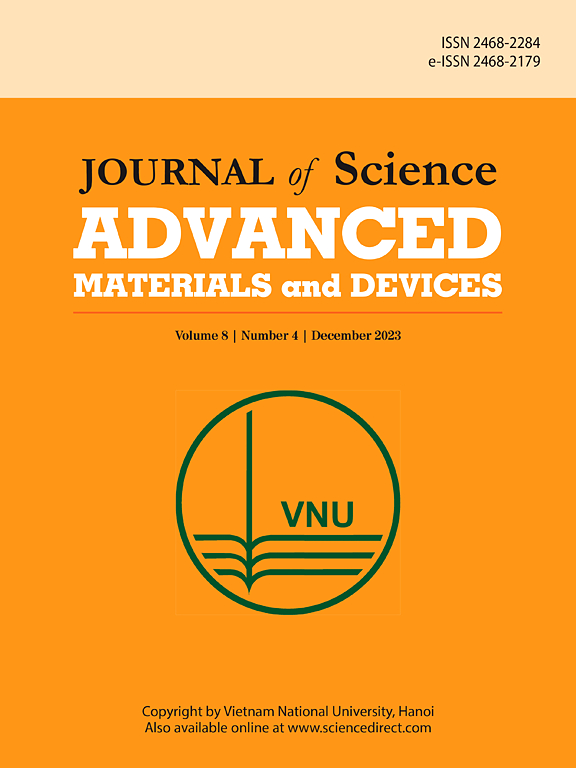铜衬底二氧化锡薄膜的结构与抗菌性能
IF 6.8
3区 材料科学
Q1 MATERIALS SCIENCE, MULTIDISCIPLINARY
Journal of Science: Advanced Materials and Devices
Pub Date : 2025-07-03
DOI:10.1016/j.jsamd.2025.100943
引用次数: 0
摘要
采用旋转镀膜技术,在甲醇和蒸馏水中加入氯化锡(SnCl2)前驱体溶液,在铜衬底上沉积了二氧化锡(SnO2)薄膜。薄膜在300℃下退火以提高结晶度。该研究考察了Cu衬底上不同的SnO2层厚度(3层和9层)对结构、光学和抗菌性能的影响。表征技术包括x射线衍射(XRD),扫描电子显微镜(SEM),原子力显微镜(AFM),紫外可见光谱和傅里叶变换红外(FTIR)。该研究特别研究了不同的SnO2层数(3和9)对复合材料性能的影响。结果表明,增加SnO2层数会影响表面粗糙度、晶粒尺寸、光学特性和抗菌效果。XRD分析显示,衍射模式发生了变化,表明晶格层数增加。SEM分析发现孔隙度增加,密度降低,而AFM证实粗糙度随着层数的增加而增加。该多层体系具有各向异性磁性,适用于磁性和自旋电子应用,SQUID磁强计测量结果显示,平行和垂直场取向之间的矫顽力场相差100 Oe。随着SnO2厚度的增加,带隙能量从3.93 eV (Cu)下降到3.89 eV(3层)和3.81 eV(9层),由直接跃迁(αhν)2 vs hν的tac图确定,表明光学性质可调。SnO2/Cu薄膜的FTIR光谱显示SnO2特征带和羟基相关峰,随着SnO2层数的增加,透光率降低,峰值更加明显。SnO2/Cu复合材料对铜绿假单胞菌的抑菌活性(n = 5个重复)随着SnO2层数的增加而提高,具有统计学意义(p <;0.05,方差分析)铜的抑制带为17±0.81 mm, 3层为21±0.98 mm, 9层为32±1.57 mm。这种活性归因于Cu2+离子和Sn4+离子的协同作用,它们产生活性氧,破坏细菌膜、DNA和细胞结构。本文章由计算机程序翻译,如有差异,请以英文原文为准。
Structural and antibacterial behaviors of tin dioxide thin films on copper substrates
Tin dioxide (SnO2) thin films were deposited on copper substrates using a spin-coating technique, where a precursor solution of tin chloride (SnCl2) in methanol and distilled water was applied. The films were annealed at 300 °C to enhance crystallinity. The study investigates how varying SnO2 layer thicknesses (3 and 9 layers) on Cu substrate influence structural, optical, and antibacterial properties. Characterization techniques included X-ray diffraction (XRD), scanning electron microscopy (SEM), atomic force microscopy (AFM), UV–visible spectroscopy, and Fourier-transform infrared (FTIR). The study specifically examines the effects of varying SnO2 layer numbers (3 and 9) on the properties of the composite. Results indicate that increasing SnO2 layers affect surface roughness, grain size, optical characteristics, and antibacterial efficacy. XRD analysis revealed a shift in the diffraction pattern, indicating lattice expansion with more layers. SEM analyses identify increased porosity and decreased density, while AFM confirms an increase in roughness with the number of layers. The multilayer system exhibits anisotropic magnetic properties suitable for magnetic and spintronic applications, as evidenced by SQUID magnetometer measurements that reveal a 100 Oe difference in coercive fields between parallel and perpendicular field orientations. As SnO2 thickness increases, bandgap energies decrease from 3.93 eV (Cu) to 3.89 eV (3 layers) and 3.81 eV (9 layers), as determined by Tauc plots assuming direct transitions (αhν)2 vs hν, indicating tunable optical properties. The FTIR spectra of SnO2/Cu films display characteristic SnO2 bands and hydroxyl-related peaks, with increased SnO2 layers resulting in reduced transmittance and more pronounced peaks. Antibacterial activity (n = 5 replicates) of the SnO2/Cu composite against Pseudomonas aeruginosa improves with additional SnO2 layers, showing statistically significant (p < 0.05, ANOVA) inhibition zones of 17 ± 0.81 mm for Cu, 21 ± 0.98 mm for 3 layers, and 32 ± 1.57 mm for 9 layers. The activity is attributed to the synergistic effects of Cu2+ ions and Sn4+ions, which generate reactive oxygen species that disrupt bacterial membranes, DNA, and cellular structures.
求助全文
通过发布文献求助,成功后即可免费获取论文全文。
去求助
来源期刊

Journal of Science: Advanced Materials and Devices
Materials Science-Electronic, Optical and Magnetic Materials
CiteScore
11.90
自引率
2.50%
发文量
88
审稿时长
47 days
期刊介绍:
In 1985, the Journal of Science was founded as a platform for publishing national and international research papers across various disciplines, including natural sciences, technology, social sciences, and humanities. Over the years, the journal has experienced remarkable growth in terms of quality, size, and scope. Today, it encompasses a diverse range of publications dedicated to academic research.
Considering the rapid expansion of materials science, we are pleased to introduce the Journal of Science: Advanced Materials and Devices. This new addition to our journal series offers researchers an exciting opportunity to publish their work on all aspects of materials science and technology within the esteemed Journal of Science.
With this development, we aim to revolutionize the way research in materials science is expressed and organized, further strengthening our commitment to promoting outstanding research across various scientific and technological fields.
 求助内容:
求助内容: 应助结果提醒方式:
应助结果提醒方式:


